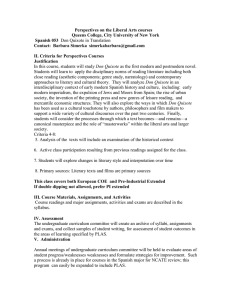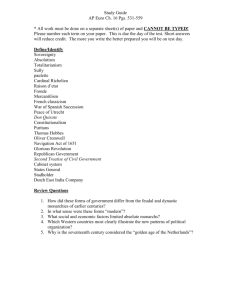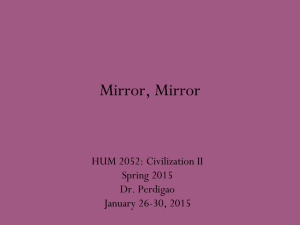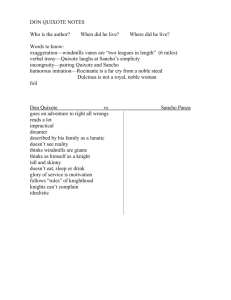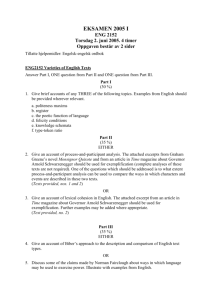The Duality of Don Quixote’s Character as Shown through Jordan Wirfs-Brock
advertisement
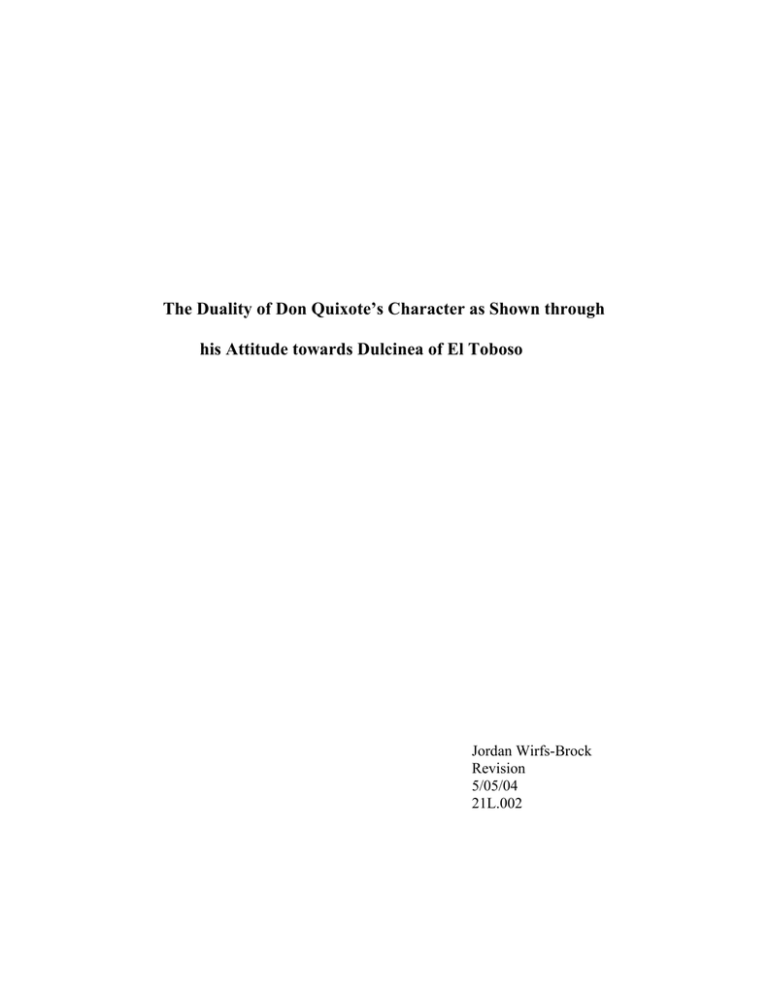
The Duality of Don Quixote’s Character as Shown through his Attitude towards Dulcinea of El Toboso Jordan Wirfs-Brock Revision 5/05/04 21L.002 At the heart of Don Quixote is the discrepancy between external appearance and internal perception. Don Quixote is a character who at first appears to be ruled by the suggestions of his active imagination. But despite his apparent insanity Don Quixote adheres to the principles of reason. The passage below emphasizes the complexities of Don Quixote’s character and reveals the often multi-faceted nature of love, women, truth, and idealism in Don Quixote. ‘And so, Sancho, for what I want of Dulcinea of El Toboso, she is as good as the greatest princess in the land. And it is not true that all those poets who praise ladies under names they choose so freely really have them as mistresses. Do you think that the Amaryllises, the Phyllises, the Sylvias, the Dianas, the Galateas, and all the rest of which the books, the ballads, the barber shops, the comic theaters, are full, were genuinely ladies of the flesh and blood and the mistresses of those who celebrated their charms? Certainly not. Most of them were invented to serve as subjects for verses and to enable the poets to prove themselves lovers or capable of being such. I am therefore content to imagine and believe that the good Aldonza Lorenzo is lovely and virtuous; and the question of her lineage is of little importance, for no one will investigate that for the purpose of investing her with any order, and for my part, I consider her the greatest princess in the world. For I want you to know, Sancho, if you don’t know it already, that two things above all others arouse love. They are great beauty and a good name, and these two things are to be found in Dulcinea to a surpassing degree. In beauty she has no rival, and few can equal her in good name. And, to conclude, I believe that everything is as I see it, neither more nor less, and in my imagination I portray her as I wish her to be both in beauty and in quality. Helen does not rival her, nor does Lucretia come near here, nor any other celebrated woman of antiquity, whether Greek, or barbarian, or Latin.’ Don Quixote, Chapter XXV The complexities and dualities of Don Quixote’s character are apparent from the very first sentence of this passage. Don Quixote’s statement that “for what I want of Dulcinea of El Toboso, she is as good as the greatest princess in the land,” (Chapter XXV) references both the comical and vaguely vulgar anecdote about the widow 1 preceding this passage, as well as the poet’s reliance on invented love described in the third and fifth sentences of this passage. The fact that Don Quixote’s words nearly mirror those of the widow—who blatantly states that “a brawny, rollicking, young lay brother” (Chapter XXV), and “ignorant hobbledehoy” (Chapter XXV) fills her needs better than any man brimming with philosophical prowess could—are an interesting addition to Don Quixote’s high-minded personality. Don Quixote is either unaware of the irony in the comparison of his own amorous ideal (one focusing on truth and beauty and honor) to the widow’s amorous ideal (one rejecting philosophy and intelligence in favor of friskiness), or is intentionally trying to show that the specific requirements of one’s love are irrelevant, and all that matters is whether they are met. The word usage in the first sentence suggests a view of love that is centered on utility. The far from romantic phrase “for what I want of [her]”, establishes a straightforward, to the point, business-like rapport. In juxtaposition with the story of the widow it emphasizes love’s pure conditionality and case-specific nature; in juxtaposition with Don Quixote’s description of poetic love, it emphasizes the love’s utility; love can be used to advance one’s personal goals. Don Quixote’s syntax and word choice as he describes poetic love sheds further light on love’s functionality. Don Quixote opens his discussion of poetic love by referring to “all those poets”, a loose collective term lacking precision and detail. The specificity generally present in Don Quixote’s language is absent in the second sentence of this passage. The phrase “under names they choose so freely” emphasizes the free will of poetic license (which Don Quixote exercises heavily by renaming key characters in his own life), but also implies a sense of recklessness. In the next sentence, Don Quixote returns to the explicit 2 detail characteristic of his usual diction as he lists specific women from literature, but the fact that he lists them in the plural (“the Amaryllises, the Phyllises, the Sylvias, the Dianas, the Galateas”) renders them interchangeable. Don Quixote further generalizes them by finishing the list with “and all the rest.” How can this loss of specificity and recognition of the falseness of literary works and the fallibility of poets be reconciled with Don Quixote’s attention to detail and veneration for literature, from which the goals of his life are drawn? The first sentence of this passage is a reference to both how Dulcinea fulfills Don Quixote’s personal ideal of love, and how his love for her is means of accomplishing his chivalrous goals. Despite the fact that love is as presented in this passage as fulfilling a purpose, it is also presented throughout the book as exclusive and exceptional. Thus Don Quixote’s specificity reflects love’s highly case-dependent nature, whereas his use of the plural and loss of precision is a reference to the universal tendency of men to rely on amorous inventions to meet their own artistic or chivalrous ambitions. The portrait painted of love in this Don Quixote is a very complex one. Love is the necessary catalyst for Don Quixote’s success as a knight-errant and the poet’s success as an artist. It is almost a prerequisite, for Don Quixote says that, “’It is impossible that there could be a knight-errant without a lady, because it is as proper and natural for them to be in love as for the sky to have stars. I can warrant that there has never been a knighterrant without amours in any history written, for the mere fact of being without them would prove that he was not a legitimate knight.” (Chapter XIII) However, love is more than a tool; it is also portrayed as something tender and sincere. Although Don Quixote feels obligated to find an amorous object in order to embody true knight-errantry, this 3 obligation requires that the love he finds be genuine. Love itself is highly idealized, and as a consequence the object of love can be nothing less than ideal. On one hand, Don Quixote is announcing the falseness of the idealism of love, pointing out the absurdity of the female ideal; on the other hand he is completely buying into this idealism. Don Quixote poses the question of whether the celebrated women he names are “flesh and blood”, and then quickly answers it with the notably concise sentence “Certainly not.” This is perhaps one of the shortest sentences Don Quixote ever utters—a marked departure from the verbose sentences he uses in the rest of this passage—and it generates a veneer of sanity and logical soundness. Cervantes cites Don Quixote’s adamant belief in chivalric texts as the root of his insanity; throughout most of the book Don Quixote fights in the name of the fidelity of chivalric texts. Don Quixote bases his life purpose on upholding the truth he perceives in literature, but at the same time he acknowledges that the truth is based on certain false assumptions. These false assumptions, such as the virtue and beauty inherent in the female ideal, are less important to Don Quixote than the overlying principles of chivalry. He is willing to accept false premises as long as they uphold his values. The powers of perception Don Quixote displays in this passage suggest that perhaps Don Quixote is not as insane as he appears. He possesses the ability to distinguish fact from fiction, but merely chooses to believe in fiction because he respects the moral principles of chivalry. At the same time, Don Quixote is willingly altering his own worldview, and the fact that he chooses to live in a world where his perceptions are highly skewed from reality is a sign of insanity. This passage also reveals a great deal about the nature and portrayal of women in Don Quixote. Women play a dual role of influence and passivity, which is articulated in 4 Don Quixote’s description of poetic love. On the one hand, women of great stature “were invented to serve as subjects for verses” (Chapter XXV). The use of passive construction in this phrase renders women nearly inanimate, and the words “serve” and “subject” have multiple connotations. To serve as a subject can mean literally to be a topic of a literary work, or to be an obedient servant under an enforced rule. On the other hand, women are also described as “enablers” of poetic talent, which is a much more active role. Without women poets would be empty and wordless. Women are concurrently described as submissive and powerful. Without women men are powerless, yet the power poets and knights derive from women is used to dominate them. It is ironic that Don Quixote claims the goddess-like women he names don’t truly exist, for these types of women keep showing up in the story. Luscinda, Dorotea, Zoraida, Dona Clara, and Marcela are all examples of unprecedented fantastic beauty. The absurdity and humor of this situation is brought up in Chapter XLII, where upon Dona Clara’s arrival at the inn the narrator remarks, “If they had not already seen Dorotea, Luscinda, and Zoraida at the inn, they would have doubted whether she had her rival for beauty.” These women embody the feminine ideals of honesty, chastity, and beauty. Their frequent appearance blurs the lines between fantasy and reality in Don Quixote, and insinuates that perhaps the storyteller himself believes Don Quixote’s assertion that the validity and significance of personal interpretation rivals that of the external world. Following the example set by the great poets he describes, Don Quixote remarks, “I am therefore content to imagine and believe that the good Aldonza Lorenzo is lovely and virtuous,” (Chapter XXV). One of the most striking things about this sentence is that 5 Don Quixote refers to his love by her true name. Within the context of this passage, Don Quixote refers to her three different ways, first as Dulcinea of El Toboso, second as Aldonza Lorenzo, and third simply as Dulcinea. Each address has its own implications. The first name he gives her is highly formal and represents the image Don Quixote has built in his mind of the lady for whom he fights. His ceremonious declaration of both her name and suffix arouses a feeling of distance. The second name he gives her reflects the outward reality of the situation. Don Quixote fully understands that he is intentionally creating an image of Dulcinea within his own mind. Furthermore, he is able to recognize the reality upon which his illusion is loosely based. The third name he gives her is informal and sentimental. It is used in a context of exclamations of Dulcinea’s beauty and decency, and shows that even though Don Quixote’s love stems from a constructed ideal, he still acts as if it is tender and genuine. In this passage Don Quixote goes through three distinct stages: conception of his ideal and its purpose in his life, acceptance of the inviability of his ideal in the context of ordinary reality, and amorous devotion to his imaginary ideal despite his realizations. Don Quixote constructs his ideal through imagination and belief, two concepts which at first seem somewhat irreconcilable. Imagination involves creativity and invention, whereas belief involves unadulterated conviction. To believe in something which one has imagined is to intentionally put one’s faith in falsehood. However, since falsehood of it comes from within the mind of the believer, the believer cannot help but accept the false belief with conviction. In this way imagination and belief are consistent with each other, and self-delusion becomes internally justified. 6 When Don Quixote says, “I believe that everything is as I see it, neither more nor less, and in my imagination I portray her as I wish her to be both in beauty and in quality” (Chapter XXV) he describes a process through which he can define his own reality. Two different meanings of this statement can be rendered from the physical and psychological connotations of the verb “to see”: to accept as fact everything the eyes see, or to believe everything the mind thinks. Both interpretations accurately describe Don Quixote; he often sees with his eyes manifestations he creates in his mind. For example, when Don Quixote acquires “Mambrino’s helmet” he says to Sancho “Tell me! Do you not see that knight riding towards us on a daple-gray steed with a helmet of gold on his head,” to which Sancho replies “What I see and make out…is nought but a man on a gray ass like my own, carrying on his head something that shines.” (Chapter XXI) Don Quixote believes everything is exactly as he interprets it in his own imagination. But Don Quixote’s delusion is far from simple. He admits to himself that he is creating an idealistic world based on upholding chivalric principles, yet this manufactured world becomes reality within his own mind. While this concept may seem irrational, Cervantes plays with its validity in points in the book where Don Quixote’s idealistic reality actually does manifest itself in the realities of the other characters. One example of this, the common appearance of unrealistically chaste and beautiful women, has already been mentioned. Similarly, when Don Quixote dreams that he is slaying the giant that has been tormenting Dorotea, he wakes up to find that Dorotea has been liberated and his quest has in fact been accomplished. (Chapter XXXVII) If the desired outcome is achieved, does it matter that Don Quixote did not slay a real giant? Cervantes uses this unconventional actualization of Don Quixote’s fantasies to suggest that there is no absolute reality, and 7 the only reality of which one can be certain is the one he creates for himself. Cervantes presents the novel in a historical nonfiction framework, and even uses the interruption of the narrative to remind the reader of this format. Through this writing method Cervantes plays with the idea of absolute and relative truth, and dares the reader to try to identify which is more reliable. As a whole this passage implicates that Don Quixote projects an outward insanity that is nonetheless based on internal logical consistencies. Don Quixote is acutely aware of the logical process through which he develops his extremely idealistic delusions. How can someone be truly delusional if he is aware his delusions are fantasies? Don Quixote’s personality is ruled by dualism, and the duality present in the portrayal of women and love within this passage serves to reflect that. 8 MIT OpenCourseWare http://ocw.mit.edu 21L.002 Foundations of Western Culture: The Making of the Modern World Spring 2010 For information about citing these materials or our Terms of Use, visit: http://ocw.mit.edu/terms.
